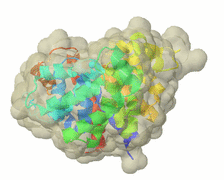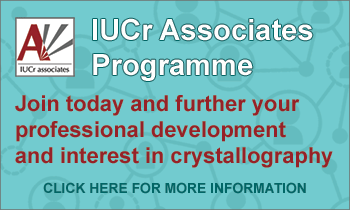enhanced figures frequently-asked questions
|
Enhanced figures in Crystallography Journals Online are interactive visualizations of crystal and molecular structures that appear in many journal articles. They use the open-source Java program Jmol and can contain author-created scripts to show different aspects of the structure. Basics
Submission |

Click on the figure for an example. |
BasicsHow can I test the enhanced figures toolkit?We do not offer a test version of the toolkit. However, you are welcome to upload a CIF and create an enhanced figure without submitting it to an IUCr journal. Just go to http://submission.iucr.org/jtkt, supply your email address, and upload your CIF. Note that the toolkit pages are not encrypted, so you should not use this service for commercially sensitive data. When you have finished experimenting with the toolkit, please use the option on the main edit page to delete the files that you have created, in order to reduce the file storage burden on our server. Can I create enhanced figures for publication in other publishers' journals?In principle, yes. The enhanced figure web page that you create is a single HTML page containing all the scripts needed to interact with the Jmol applet in the ways you have determined. For use on another publishers' web site, you would need to change the locations specified in the web page for the CIF that supplies the data, and also the Jmol Java applet and its supporting JavaScript library. At present we do not know of any other publishers who will support routine publication of such figures, but we would certainly be willing to work with other publishers who wish to develop a similar service. You may also use the emhanced figures toolkit to create high-resolution TIFF graphics for publication elsewhere. If you do so, please acknowledge the source of the illustration in the following way: Figure created by Jmol (www.jmol.org) using web services provided by the International Union of Crystallography. Why can't I use RasMol, PyMol, [ ... insert favourite software ...] to create an enhanced figure?We shall be happy to consider entending the enhanced figures service to include other software packages if they can meet the architectural requirements of the service. These are:
SubmissionHow and when do I submit an enhanced figure?Normally you should create and edit your enhanced figure before submitting an article.
Why does my enhanced figure not transfer to my submission?If you have created an enhanced figure, and it does not transfer to the submission system when you enter its view URL into the source file upload page, this usually indicates that you did not save your enhanced figure using the 'Primary save' feature of the editing toolkit (the button marked 'Save current view as main figure'). You should revisit your enhanced figure using the edit URL, and make a primary save, before trying again. How secure is my enhanced figure submission?The IUCr offers the submission of enhanced figures in the same spirit as submission and review of research articles: we provide a confidential but not impregnable environment for reviewing material intended for publication following quality assessment and acceptance. The identifying URLs that allow you to edit your enhanced figure are not guessable or listed in web-crawlable form. However, if someone obtains the URL, they have free access to the material. There is no SSL encryption or other such precautionary security measure. You should not, therefore, use the enhanced figure service for sensitive data. |


 menu
menu



